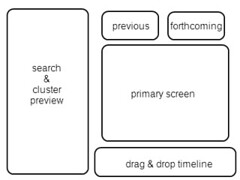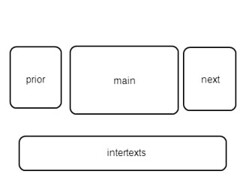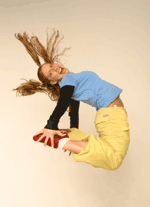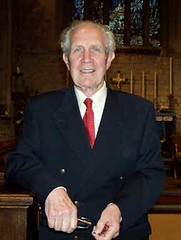splines in space
theorising through (dance) practice
tumble blog
published 15 May 2007 by mpgough.networked choreography - ii
published 11 March 2006 by mpgough.Katrina McPherson & Simon Fildes propose that hyperchoreography is the natural extension of indeterminacy in mediated dance praxis. drawing on a range of texts and concepts they seek a structure in which the audience is "free to select, interpret and enjoy the work from their own perspective":
this ideal text is a galaxy of signifiers, not a structure of signifieds; it has no beginning; it is reversible; we gain access to it by several entrances, none of which can be authoritatively declared to be the main one; the codes it mobilises extend as far as the eye can reach, they are indeterminable [Barthes *]
whilst not aligning the concept with chaos theory let me define indeterminacy of meaning in dance praxis as 'interpretive dependence on initial conditions'. such a definition applies equally to the producer, process, performer, product & perceiver of a dance work.
if the initial conditions (the movement corpus) of a dance work are small and ring-fenced (the choreographer produces, selects and controls the material) then our bias for particular semiotic readings results in a low level of indeterminacy. the only way to achieve 'maximum' indeterminacy is for the choreographer to exert minimal control over the movement corpus.
'minimal control' of the corpus need not mean 'found' choreography in the tradition of 4'33", if we define choreography as 'making structures in which movement may occur' then the choreographer can still retain some ownership of contextual meaning. presented in an appropriate structure, divergent content forms the dissonant harmony of authored indeterminacy.
yet existing examples of hyperchoreography are 'fabricated' rather than 'found'. The presentation of a contiguous movement corpus via pseudo random, non-linear and asynchronous devices do not lead directly to indeterminability of meaning. exposure to post-modern narratives has developed our skills of discerning the 'difficult whole' from it's fractured parts; 'the author is dead, long live the author'.
between the 'found' and the 'fabricated' theoretical notions of hyperchoreography offer the 'facilitated'. the 'new' developments that hyperchoreography offers are of form rather than content, a networked mediation and visualization of motive intertexts; articulated intertwingularity.
in a networked environment where all links are revealed and 'new' links can added by users, multi directional - two way connection enhance the perception of intertexts. no longer must the author use chance procedures to disrupt their unconscious constructions of meaning, the provision of a mechanism to explore, expand and visualise the intertexts of their authored text performs the same function.
but we can go further ... i suggest we can best preserve the Dasein of 'filmed' motion by presenting it 'as is' - multiple representations reveal no more than a detailed examination of a single artefact. the intertwingularity of content on sites such as flickr is enhanced by user annotation, tagging and clustering. the audience is left navigate the interpretive space from their own perspective whilst divergent contexts are offered for further exploration.
by leveraging the developments of Web2.0 hyperchoreography can achieve it's conceptual promise. Users would upload video files of dance to a central server and annotate the files with relevant meta data and tags. each video would be converted into a common format and time code segmented to allow multiple points of entry (see google video example)
from here any user can make use of a basic on-line non-linear editor to organise multiple videos into a hyperchoreography, but what's important here is that the motive context and intertexts are preserved. i've drawn up a basic sketch:

so what you see is the editing layout ... the user can search for video files via tags etc., these can then be dropped into the time line. above the main window the previous and next video clips are shown in thier contextual time spaces. for example, if clip 2 is playing the user will be able to see clips 1 (prior) and 3 (next). the presentation of these clips is relative to the edit, so if the user only uses clip 3 from timestamp 00:30 the clip will preview in the 'next' window starting at the 00:00 timestamp 30 seconds before it occurs in the time lime. as each new clip enters the primary screen a clips in the search will will change to reflect it's motive intertexts
so far we have a tag assisted on-line video editor ... so how do we make the leap to hyperchoreography? well after the editing has been finalised we can save the work and go to the viewing screen:

it's important to note here that 'saving' the video does not create any 'new' material, we are actually transcluding the original video files. this means that each video is actually a string of references and connections that can be further annotated.
in the viewing interface the main, prior and next screens have the same functionality as in the editing mode. the intertexts panel shows active video thumbnails of videos based on annotations in the main, prior and next screens, clicking on these thumbnails will load other users video compilations. thus simply by watching and selecting or creating new connections and meanings the audience can freely assign their own perspective and interpretation. Hyperchoreography thus becomes the act of choreographing or navigating through motive intertexts as opposed to asynchronous web based dance for camera.
so i'm going to stop here for now, and continue later. if you are wondering about dance mashups then head over the Great Dance Weblog and read 'Spreading Dance with Mashups'. remeber that the difference between that and what i'm proposing with hyperchoreogaphy is the concurrent visualization of the motive intertexts and the ability to navigate those intertexts.
now with all this talk of video on the web let me point you to towards Dance Vids [via DA ... NCE], media rich david-o.net and if you want to keep up to speed with networked arts praxis, there is the excellent networked_performance from which the title of the series of posts is borrowed.
go-sees:
- Interview with Another Language About InterPlay
- Internet2 and Expanded Opportunities for Arts and Performance
- visualcomplexity
Tina Bausch
published 23 February 2006 by mpgough.amusing typo (well it made me laugh over my breakfast) in The Guardian, both online and in print.
I'd have Quentin Tarantino as the director, and, as a complete contrast, directors Kar Wai Wong and Alan Plater, and maybe Tina Bausch to choreograph it.[Akram Khan]
i doubt kahn make this mistake, must be a non dance informed editor
What I'd do if I had the money: Akram Khan, choreographer/dancer.
kalte Hände
published 06 February 2006 by mpgough.i used to know a fantastic dancer called Sabrina, really hard-working dedicated and a real pleasure to be around. she always complained she had kalte Hände, and it's something i still say when it's chilly and i have no gloves. as usually happens, we lost contact ... but the other day i discovered how to contact her and sent of an email. i hope to hear back from her soon ... she seems to be doing very well for herself.

when i was a choir boy i used to warm my hands by putting them into the sleeves of my cassock. i had a great choir master called Malcolm Mckelvey, he taught me how to sing and lots more beyond ... including my love of JS Bach and Baroque music in general. my thoughts go to his family, as i know how deeply this news has affected me.

Malcolm McKelvey
networked choreography
published by mpgough.whilst my views on the shortcomings of hyperchoreography are a matter of public record, i no longer wish to criticise without making a positive contribution. i do believe that the notion of hyperchoreography and it's theoretical basis are sound, what i take issue with is the current implementation(s) [1] and supporting documentation [2]. i don't think that Miles' essay contextualises the practice with enough rigour whilst Popat & Smith-Autard's paper is significantly out of date (based on 1999 web technology). I've linked to Whyte's paper before, but whilst it is an excellent essay it doesn't support their practice. so, as part of developing my 'projective practice theory' i have written a paper that seeks to realign hyperchoreographic practice with it's theory.
my feeling is that the present examples are asynchronous dance for camera. if the goal is "non-literal/ non-representational/ non-narrative" that preserves the dasein of human movement and its physical properties of weight, mass and un-enhanced physicality" then some deep level reimplementation is required. However, what i find interesting is that most of the solutions lie within Nelsons original concepts of hypertext. The key principles that hyperchoreography must adhere to are:
- transclusion
- multi directional linking
- user annotation.
- user contribution
Drawing on existing implementations of Web 2.0 technologies such as 'Flickr' and 'Goolge Video' we will illustrate how hyperchoregraphic practice could be realigned with its theoretical basis. This re contextualised application will reveal the possibility of distributed choreographic collaboration and (concurrent) visual representation of motive intertexts. Using an example of the proposed interface we will show how the 'user' will not simply a participant in the compositional process, but fully responsible for the choreographyi'll let you know what happens with the paper and post more details / content as i am able.Whatever happens i will also submit an essay to the hyperchoreography site that presents a deep contextualisation on the theoretical and practical issues involved.
[1] hyperchoreography works
[2]
Writings about hyperchoreography
title of this entry with apologies to networked performance
race & gender (etc.) malarkey
published 02 February 2006 by mpgough.i tend to be on campus late into the evening, over the last week or so i have had the feeling people have regarded me with suspicion. now i find out why; a hoax email is being sent via the uni email that reads something like this ...
To: xxxxx@uea.ac.uk
Subject: CCTV still of Rapist
Hello,
During the early morning of January 25 2006, a campus student was the victim of a horrific sexual assault within college grounds. Eyewitnesses report a tall black man in grey pants running away from the scene. Campus CCTV has caught this man on camera and are looking for ways to identify him. If anyone recognises the attached picture could they inform administration immediatelyobviously there is no image, the file is a virus payload ... but the email seems to be spreading meaning that people are taking it seriously. Hoax and virus emails are designed to be plausible by fulfilling our stereotyped concepts of reality
its' sad people still believe all that malarkey
recent posts
archives
newsfeed
blogroll
- ArtsJournal (dance)
- Break-A-Leg
- DA ... NCE
- Dancehunter
- david-o.net
- Downtown Dancer
- Great Dance Weblog
- Leigh Witchel
- motive (reason to move)
- Newness Dance
- Onward and Upward
- Rachel Howard.com
- Sort of a weblog
- thewinger
- uncoy.com | la vie viennoise
- We All Dance
- 3hive
- Archinect.com
- Cat and Girl
- Drawn! The Illustration Blog
- media art net
- networked performance
- PostSecret
- we make money not art
- usergland